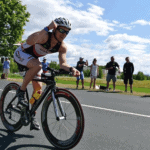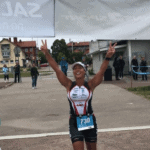
Sprint Triathlon Training Plan – What You Should Know About The Sprint Distance
Page Contents
If you are a beginner looking at entering your first triathlon, following a sprint triathlon training plan is a good start.
Sprint Triathlon Training Plan
Most people see triathlon as the gruelling Ironman event, athletes struggling on the run, surrounded by a large crowd of supporters. In reality, there are numerous, triathlon events. Sprint triathlons provide a more action-packed, fast-paced event than its counterpart. A sprint event starts with a 750m swim, 20km bike and 5km run and is well suited to the beginner looking to get into triathlon.
A 10-12 or 16-week sprint triathlon training plan can help you complete your first sprint event. Whether you choose a structured sprint training plan or triathlon coach, a successful training should include:
Consistency in your training – Improvements in your fitness come from repeated practice. Focus on swimming, biking, and running for at least 8-12 weeks before entering your first event. A structured triathlon training program will help to increase your speed, maximise your preparation for the event and help with consistency.
Recovery from Training – Recovery is as important as the training itself. As a beginner triathlete, plan your weekly training around one rest day per week. Every 4-5 weeks introduce a recovery week to help the body become stronger and adapt to the stress placed on it. A periodized sprint training plan can help you reduce the risk of injury and allow for adequate recovery.
The Sprint Triathlon Swim – What Should You know?
A sprint triathlon swim is short, but often the most nerve-wracking part of the race for new athletes. Training to swim longer will help you to improve your overall swim fitness. Learning to swim in open water can help sighting during the event, so you don’t end up swimming further than needed.
Focusing on basic strategy will help you get through the swim easier, which can ease pre-race nerves. By incorporating swimming drills to build speed and efficiency will help to improve your swim time considerably. Swimming drills help you to improve your form and make you a more efficient swimmer.
Below are a few basic drills for the Intermediate triathlete:
Catch Up Drill
Using a normal swim stroke pause your stroke (arm) when fully extended in front of the body until the other stroke (arm) catches up.
One Arm Drill
Extend your arm in front of your body while the other arm sits parallel to the body. Focus on swimming with a regular kick. Alternate according to fatigue.
Arm Drill
Focusing primarily on your arms. Swim either with a pool buoy or prevent your legs from doing any kicking.
Beginners tend to make a mistake by swimming exclusively indoors. Focus on practising swimming in the open water during your sprint triathlon training. Open water swimming helps with both sighting and comfort in the rough seas.
The Sprint Triathlon Bike – What You Should Know?
Depending on the sprint course, the bike leg can become quite challenging. If the course has lots of corners or hilly, you can expect a higher power and fitness needed than a flat course. For most beginners, the sprint cycling portion will most likely be the easiest of the three disciplines. During your cycling training, learn to control your cadence by shifting gears over different terrains.
No matter the bike you have, focus on riding a range of terrains. Rolling terrain and windy rides will help you learn to adjust your cadence accordingly. On hillier rides, make sure you keep the gear at a suitable level not to overload your legs with lower cadence (under 70rpm). Overloading the legs during the sprint triathlon will have an immediate impact on your run off the bike. Focus three days per week on the bike and that will be enough cycling for your sprint triathlon training plan.
The Sprint Triathlon Run – What Should You Know?
Running is the most natural of the sprint disciples, but for some, this is the hardest part of the race. The body is already fatigued from the swim and bike, and on the run, it starts to catch with you. Building your running training slowly each week and incorporating brick sessions into your sprint plan, can help muscles adapt to running off the bike. Brick sessions are back to back workouts consisting of running and cycling.
Be careful not to increase your weekly running volume too quickly and allow for adequate recovery preventing injury and overuse.
The Sprint Triathlon Transitions
Transition is switching from one sport to the other. Before the start of the event, athletes set up their cycling and running gear in the transition area.
Swim to Bike Transition – The transition of stripping off your wetsuit, removing your googles and putting on your running shoes. Before exiting the transition, make sure the helmet is fastened correctly. Walk or run with your bike until the transition line before mounting your bicycle.
Bike to Run Transition – Once you have finished the bike, dismount before the transition line and walk or run to your marked transition area. Re-rack your bike, remove your helmet and switch from your cycling to running shoes.
Beginner’s Training Plan
Now you understand the basics of completing a Sprint event, For beginner triathletes, a 12-week sprint triathlon training plan is an ideal length. We at SportCoaching prefer to provide a custom 16-week sprint triathlon training plan, which allows more time and an injury-free in the build-up.



